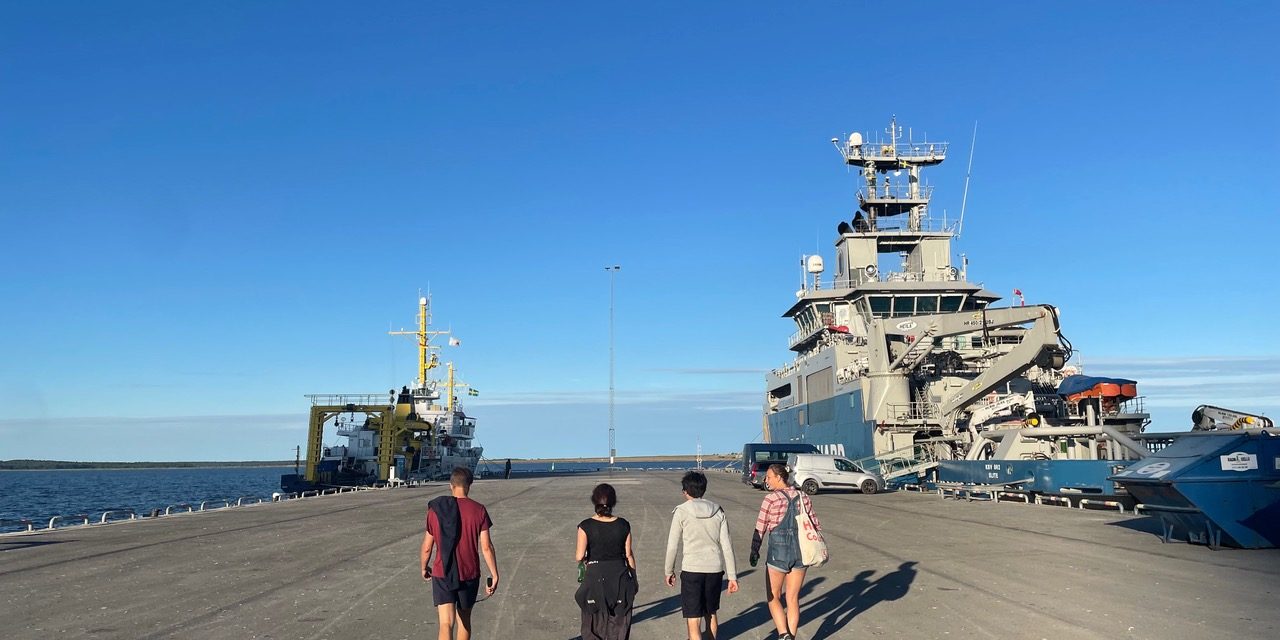Trouble with Bubbles at Sea
Blog in a Teacup by Dr Helen CzerskiWe are in Sweden, moored in a port in Gotland. We are not supposed to be in Sweden.
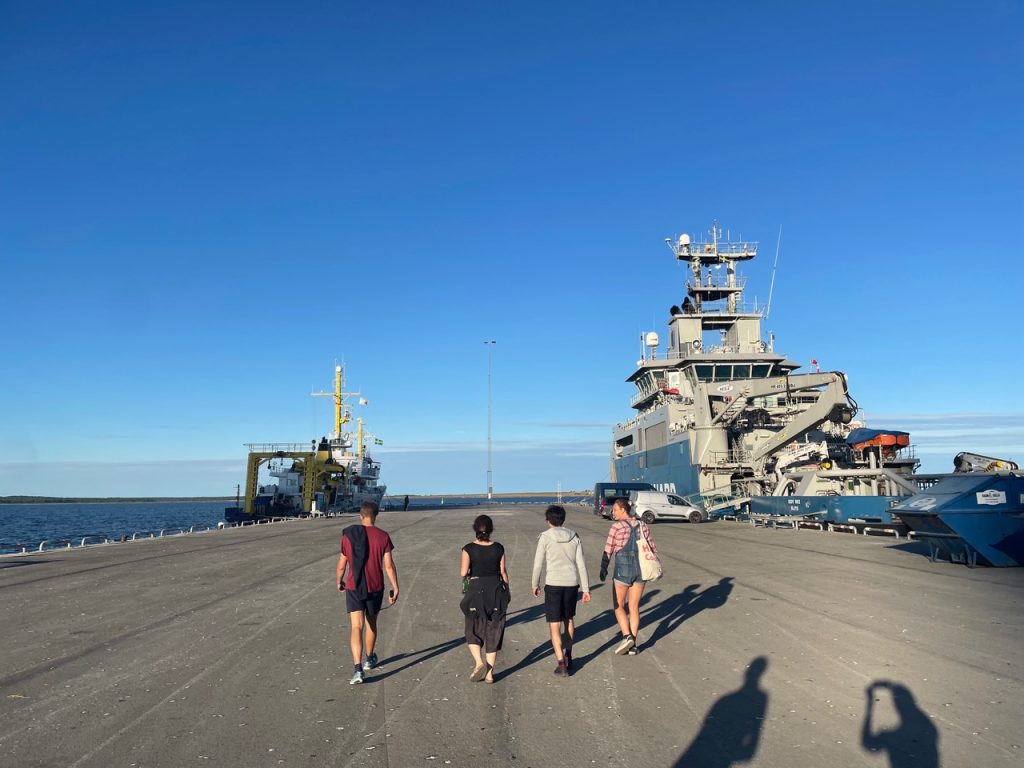
The event that put us here was the most serious setback so far, but the list was already long and growing. Over the past ten days bad luck has dripped and seeped and then poured into the ship, and we have adapted and problem-solved and worked-around and stayed up very very late to keep the show on the road. The science of hunting the invisible is supposed to be hard, but it feels as though we’re writing ourselves into research cruise myth now. Today happens to be the Chief Scientist’s birthday. He is certainly not going to forget this one.
***
The Baltic Sea is an unusual place. A huge amount of water drains off Sweden, Finland, Estonia, Russia and Latvia and flows down to form a reasonably large shallow sea that’s only 55m deep on average. It’s just barely connected to the Atlantic by a narrow and shallow channel between Denmark and Sweden, so very little seawater can get in to mix with all the river run-off. The consequence is that the surface water is only around 20% as salty as the global ocean, and it forms very obvious layers of different temperatures and salinities. But it’s still big enough that lots of gas can come and go across the surface, from atmosphere to sea and back again, and the point of our time on this research ship is to take measurements that let us understand that breathing process better. To do that, you have to get out there and sit in the middle of these itinerant gases, so our home and floating laboratory for these three weeks is the R/V Elizabeth Mann Borgese, a small German research ship based in Rostock.

It was a slow start. Two of the people due to come on the trip got Covid the week before, and so the ship stayed in port to wait for them to test negative. No-one really minded, because our scientific instruments were not playing ball and being able to go to the nearby hardware store was extremely useful. I ordered a replacement timer for my bubble camera which was delivered to the ship in port the next day, with an address that boiled down to: Helen, ship Elizabeth Mann Borgese, and the port road address. Covid officially banished, we were allowed to set sail as long as everyone wore masks everywhere indoors and we trundled along daily to the ship’s medical room so that the Second Mate could poke about in the surprisingly deep inner labyrinth of our nostrils with a covid test swab. The first real celebration on the ship was when the allocated five days of covid tests were over.
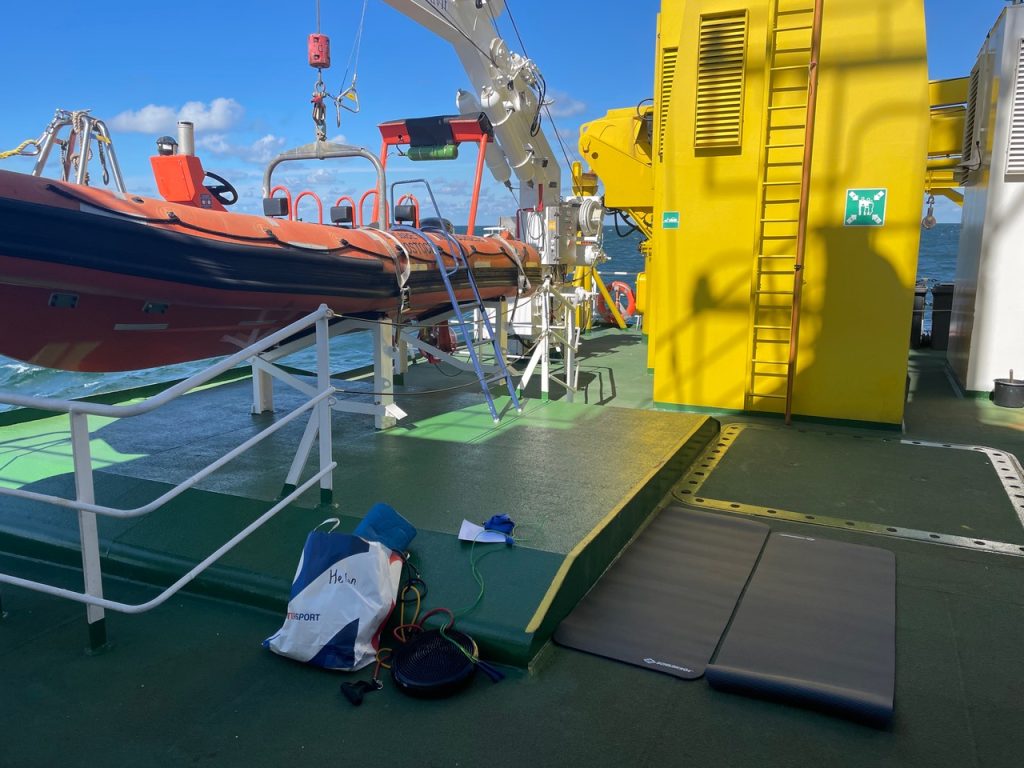
There are two main ways of measuring the ocean breathing. One is to watch the concentrations of gases like carbon dioxide in the air as it moves up and down, applying the basic principle that if gas is coming out of the ocean there must be (on average) a slightly higher concentration as air moves up compared with when it’s moving down. The other way is to inject two known inert gases into the surface of the ocean, and then follow this adulterated patch around to see how quickly those gases are lost to the air. Both are being used on this ship, but the narrative of this trip is all built around the daily drama of The Patch: where it is, where it’s going next, and what shape the wind and currents have squeezed it into.
This really is a case of hunting the invisible – the only way to find the patch is to sample water that is continuously pumped on board and to map out the concentrations. Wind, currents and eddies all muck about with the patch, so you don’t know where it’s going to go next. We sailed out into the middle of the Baltic, between Latvia and Sweden, but injecting the patch into the water had to wait the measurement instruments had been coaxed into action, something that cost a lot of people a lot of sleep. Finally the patch was created, and everybody relaxed. But 12 hours after injection, there was no sign of it. We steamed around in grid patterns, checking current measurements, looking for any hint of the tracer gases in the water. Eventually, around 4am, we found it, and the story of The Patch had finally begun. Now the day is split into three eight hour shifts, and three of us take turns to watch and map the patch evolution. At 6am and 6pm every day, we stop and take water samples at different depths (which are used by lots of the teams on the ship), and we need to be in the centre of the patch when that happens. I’m here as part of the patch team so I’m helping with monitoring the patch, and my shift is from 4pm – midnight every day.
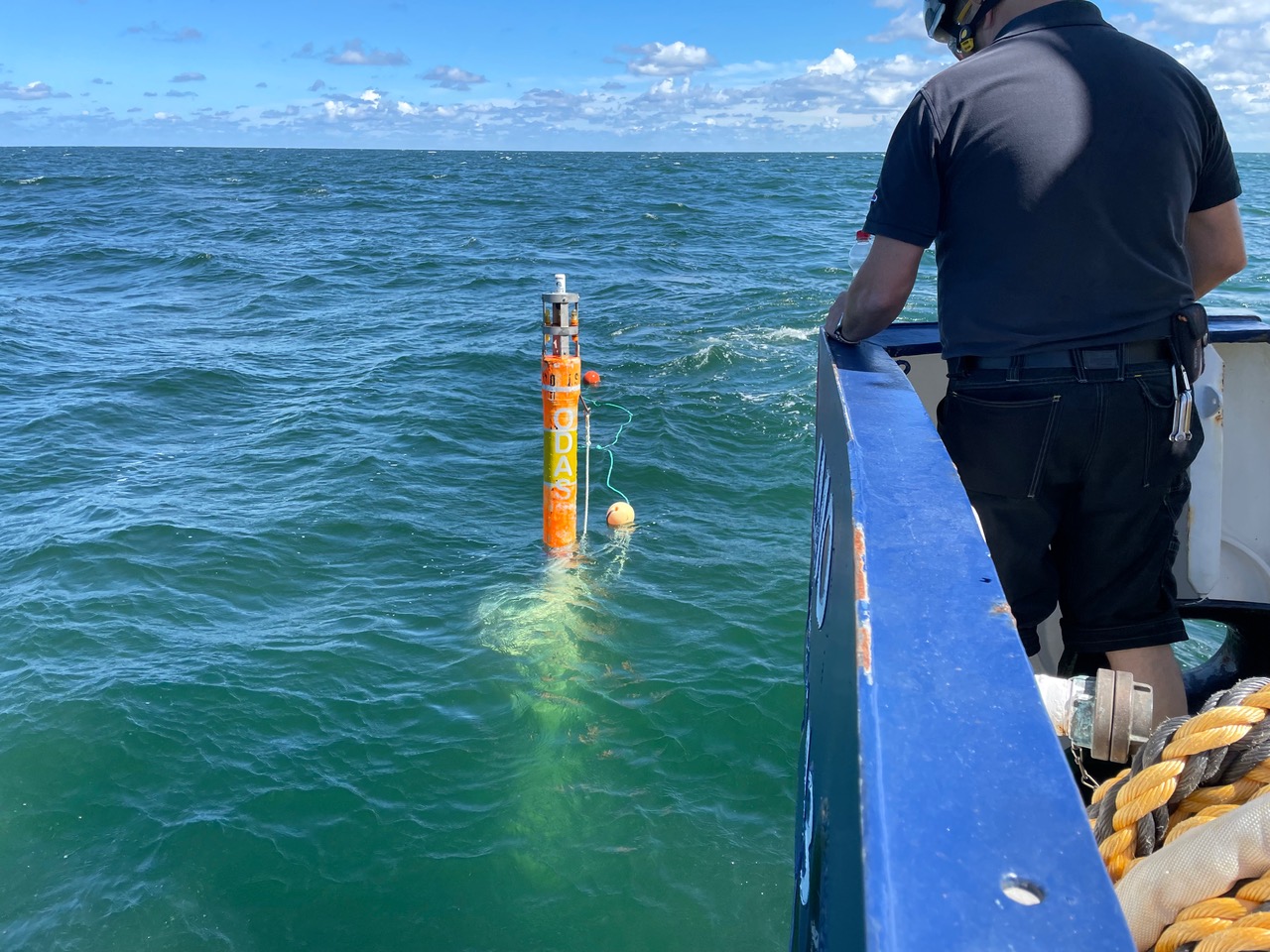
My real scientific role here is to measure bubbles, because breaking waves speed up the ocean breathing process. So I have a buoy that looks like a long white stick and floats upright in the water. It carries a bubble camera, a hydrophone and some other useful bits and pieces, and gets put over the side to drift freely for a few days at a time before we bring it back on board to collect the data. Well, it had a hydrophone.
After the first brief test deployment, the hydrophone announced with a quiet pop that it was no longer interested in communicating with my laptop. When I opened it up a stream of brown rusty water trickled out from the inside. The hydrophone had just returned from the manufacturer, who were supposed to fix this known leakage problem. But it was too late. The circuit boards had suffered several hours of seawater and the some of the chip connections had rusted right through. The hydrophone was no more.
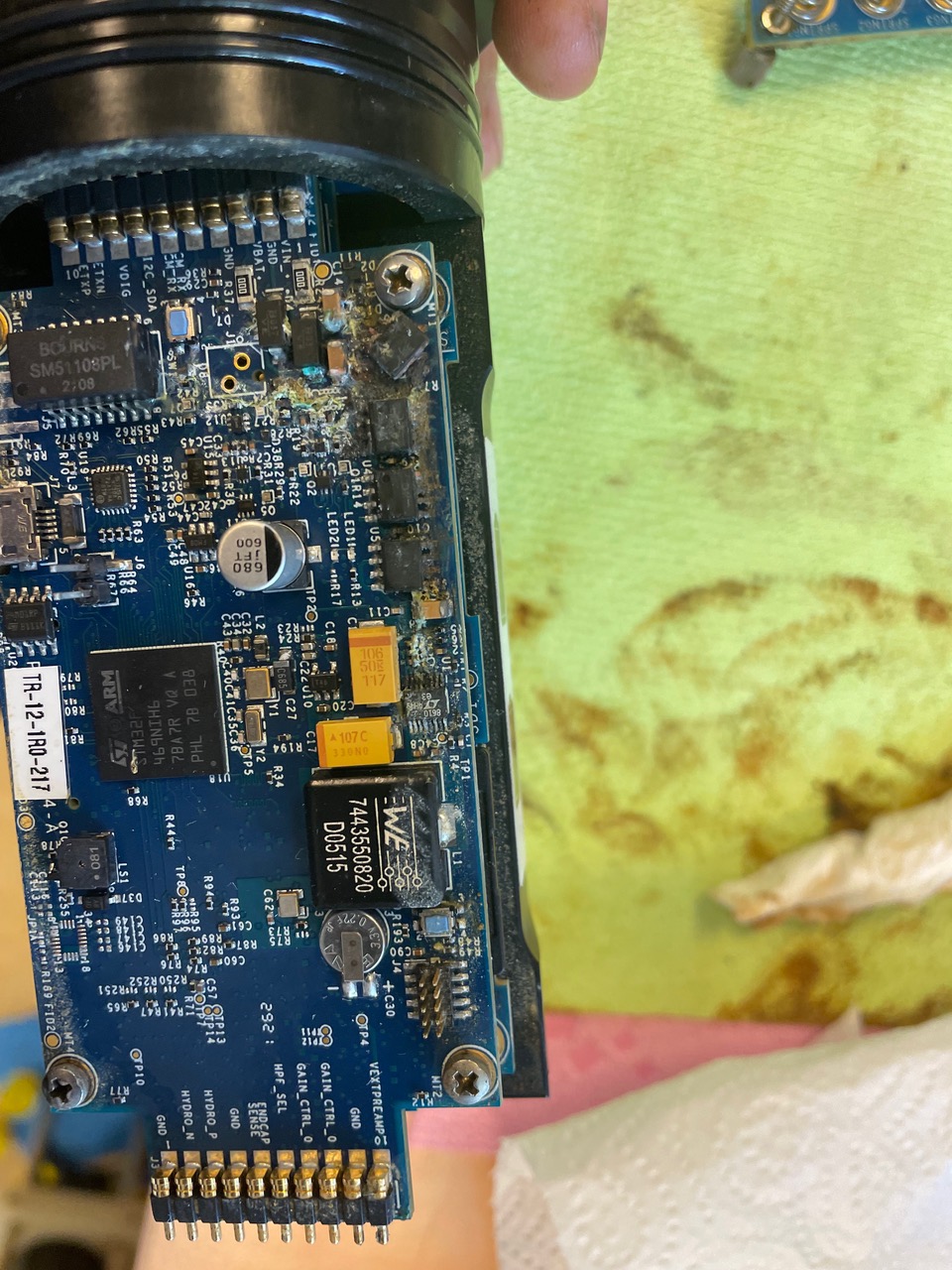
There’s a spot up on the second deck, behind the crane cabin and just beneath the bridge, where there’s enough space for a couple of gym mats. There is a “gym” downstairs, in a metal crevice next to the laundry room, but up here it’s sunny and warm and there’s more space. So I spend an hour every day skipping and doing squats, press-ups, plank and various other fidget-busting contortions. I can follow the ship on its patch search pattern as the shadow of the stack crosses my gym mats as we turn west, north, east and then north again. Other than that, the only things to worry about are preparing my scientific instruments for the bubble buoy, looking at the data they’ve brought back, and doing my shift of spying on The Patch. There isn’t much to do other than work, so I spend the morning on my instruments/data, and the afternoon watching screens downstairs. This lab space is a cramped mosaic of plastic and metal, with computer screens, large chemical analysis instruments (GCMS, for the cognoscenti), pumps, pipes, frames, multiple computers, large glass syringes, and a clutter of tape and pens and cables and notebooks. Together, all of this is capable of detecting concentrations of sulphur hexafluoride in the parts per trillion, a tiny scattering of molecules in the dense bustle of ocean water, a chemical sprinkle that that spreads out and spins and twists and escapes over time.
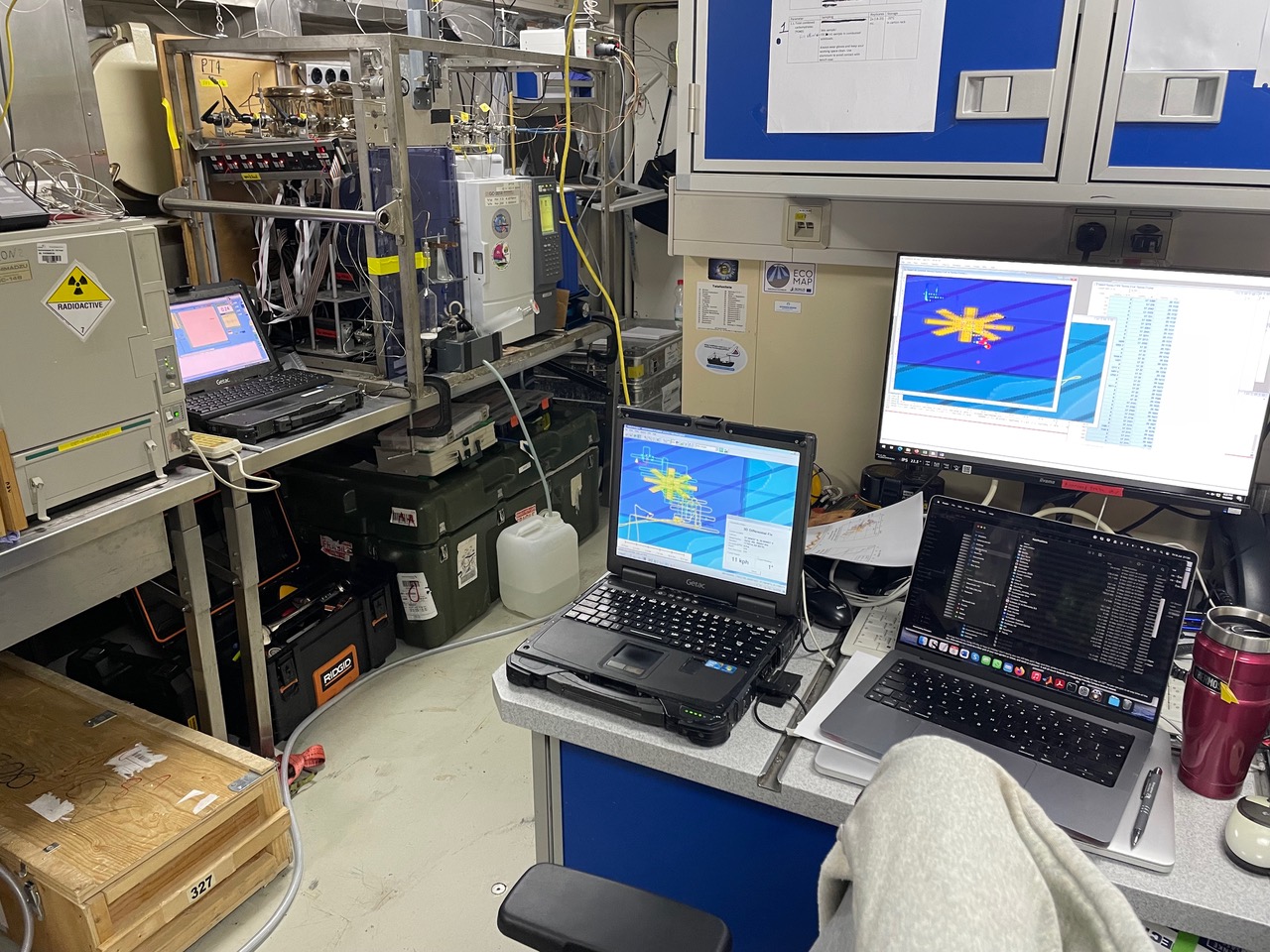
A number pops up on one of the screens every minute that has the current tracer gas concentration and based on that you phone the bridge every so often to instruct them to change direction. When I was a kid, there was a children’s TV show – I think it was called Knightmare – where a blindfolded person was guided by their teammates to step right/left/forward/back to navigate around room-sized puzzles. The blindfolded person here on the ship is whoever is on the bridge (captain or first and second mate), whose job is to keep our ship out of the path of the shipping lanes and tie the ship’s course into whatever knots the scientists fancy today. The scientists just care about where the numbers sit on the maps, and identifying the most concentrated region in a patch that is now around 4-5 kilometres long. There’s always a frisson of suspense as new numbers appear, and the numbers are all that matter. Outside there is just blue sea, as far as the eye can see, but we are not looking at that. The patch is there, sometimes – we must be looking right at it – but it’s invisible. We must not lose the patch.
The bubble buoy came back from its first proper deployment, and the camera computer stuttered and struggled and gave up. I suspect that the internal electronics overheated in these warm waters in bright sunshine, but it doesn’t matter because it’s certainly not fixable on board this ship. My faithful bubble camera is also no more. Higher winds were forecast, but this ship isn’t really capable of managing the waves that will generate (waves that would hardly count ona big ship in the open ocean, but they’re not used to them here). So we were told that we had to leave the patch for 24 hours, risking not finding it again, for safety reasons. The liquid nitrogen necessary for the chemical analysis on board was running low, but no-one knew why, and then it ran out. Someone broke one of the large glass syringes, and later emerged from the hospital room with bandaged fingers. As the cycle of shifts went round and round, there was no mealtime where everyone was present, and the tiredness started to kick in, along with the repetition and the stress.
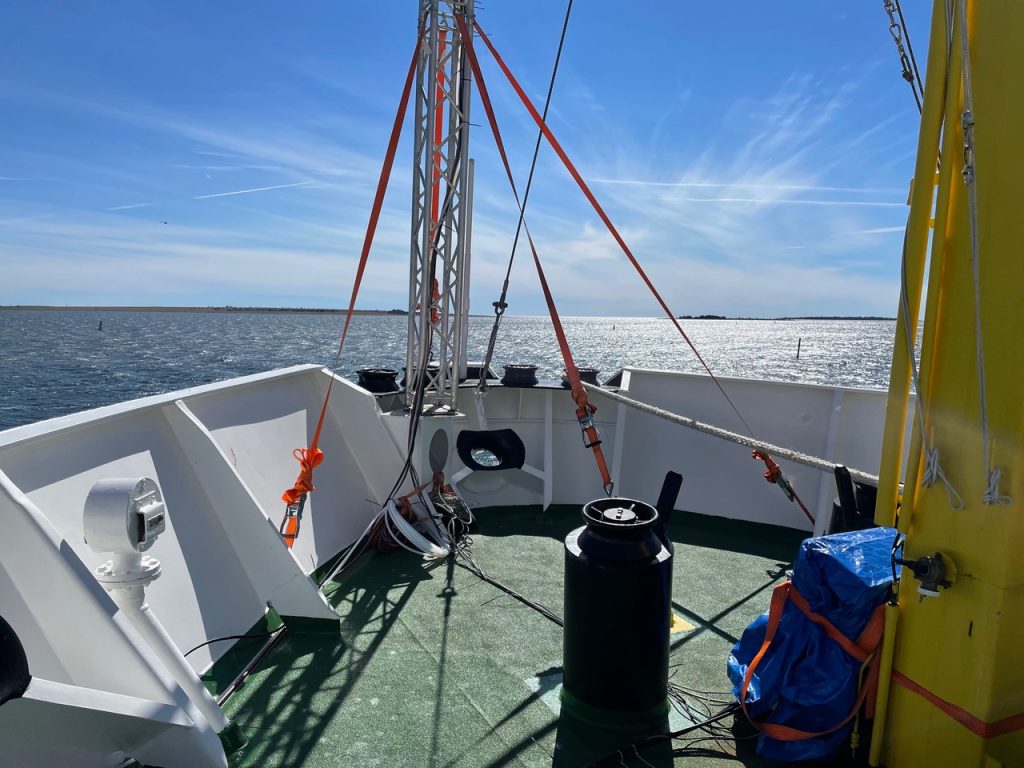
This is where teams are formed. You go to sea with people you may never have seen before and you live in your steel bubble together until everyone knows who is on which shift, who will be found staring out to sea at the muster point in the middle of the afternoon, who will be waiting and chatting on the back deck after dinner, who is taking samples at midnight every night, who has a good supply of Sellotape, and who has the best snacks. Everyone helps everyone. We are in this together. And the obstacles kept coming, and we kept working through them, around them, and we were tired, and we persisted. This is what data collection at sea is like. But this time everything went wrong, bit by bit by bit, and there was always something.
The day when we had to run from the waves was the day before the Chief Scientist’s birthday. We created a ship science birthday card for him by blowing up lab gloves to write HAPPY BIRTHDAY on, and it was hung in the mess last night ready for a celebratory breakfast this morning.

But by the time the morning arrived, celebration wasn’t on the cards. Just after I woke up I walked out on deck to find a grey concrete harbour instead of blue open sea, and green-clad paramedics waiting on the dock. There had been a medical emergency overnight, the sort that needs urgent attention, and here we are in port. The casualty has been taken onshore and then flown to a bigger hospital, and we wait. Without the liquid nitrogen that means the measurements can continue. And without our teammate. A limbo has opened up, because there is nothing to do except let the time pass. In the evening, we were allowed off the ship for a walk on shore on the island of Gotland, and we found a beach and holidaymakers and table tennis and icecream.

We plodded along the shore in our ship work clothes, out of place. It’s like a hole in time, a rip in the cruise schedule, and we have pulled apart the ragged torn edges and we’re peering through into nothingness, into someone else’s holiday. Icecream seems to be a good solution. Later on, we sit on the bird poo covered concrete dock next to the ship with the special stash of chocolate, the one you take along for either the great celebration or the great commiseration, and we sing Happy Birthday. It’s not clear whether the science will be able to start again.
 Dr Helen Czerski is a physicist, first and foremost, but she’s acquired a few other labels along the way: oceanographer, presenter, author and bubble enthusiast. A regular on The Cosmic Shambles Network, she has also presented a number of acclaimed documentaries for the BBC and her first book, Storm in a Teacup, which looked at the physics of every day things, was a bestseller. Recently she was awarded the prestigious William Thomson, Lord Kelvin Medal and Prize from the Institute of Physics.
Dr Helen Czerski is a physicist, first and foremost, but she’s acquired a few other labels along the way: oceanographer, presenter, author and bubble enthusiast. A regular on The Cosmic Shambles Network, she has also presented a number of acclaimed documentaries for the BBC and her first book, Storm in a Teacup, which looked at the physics of every day things, was a bestseller. Recently she was awarded the prestigious William Thomson, Lord Kelvin Medal and Prize from the Institute of Physics.
If you would like to reuse this content please contact us for details
Subscribe to The Cosmic Shambles Network Mailing list here.

